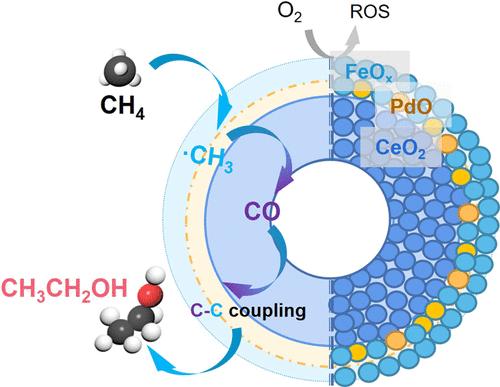Photocatalytic CH4-to-Ethanol Conversion on Asymmetric Multishelled Interfaces
IF 14.4
1区 化学
Q1 CHEMISTRY, MULTIDISCIPLINARY
引用次数: 0
Abstract
The selective oxidation of methane (CH4) features attractive potentials in both mitigating global warming and producing value-added chemicals. However, due to the short-life and unpaired concentrations of reactive intermediates (such as ·OH, ·CH3, and CO), the selective formation of multicarbon products like ethanol has remained challenging. In this work, we developed a hollow multishelled CeO2@PdO@FeOx nanosphere catalyst with two asymmetric and closely connected interfaces, featuring efficient in-tandem photo-oxidation of CH4 into ethanol with O2 as the oxidant. The outer FeOx surface promotes the photoreduction of the oxazole atoms in O2. In the meantime, the two asymmetric PdO/FeOx and CeO2/PdO catalytic interfaces enable selective photoactivation of CH4 to ·CH3 and then to CO, respectively, and the hollow multishelled structure further facilitates the directional transport and coupling of the as-generated ·CH3 and CO to produce ethanol. Under 100 mW·cm–2 light intensity and ambient conditions, the hollow multishelled CeO2@PdO@FeOx nanosphere photocatalyst exhibited a peak CH4-to-ethanol yield of 728 μmol·g–1·h–1 without photosensitizers or sacrificial agents, almost three times higher than the previous best reports on photocatalytic CH4 oxidation to ethanol, suggesting the attractive potential of the asymmetric multishelled catalytic interfaces.

不对称多壳界面上的光催化 CH4 转化为乙醇
甲烷(CH4)的选择性氧化在减缓全球变暖和生产高附加值化学品方面都具有诱人的潜力。然而,由于反应性中间产物(如 -OH、-CH3 和 CO)的寿命短且未配对集中,选择性地生成乙醇等多碳产物仍具有挑战性。在这项工作中,我们开发了一种中空多壳 CeO2@PdO@FeOx 纳米球催化剂,它具有两个不对称且紧密连接的界面,以 O2 为氧化剂,能高效地将 CH4 光氧化成乙醇。外层 FeOx 表面可促进 O2 中噁唑原子的光反应。同时,两个不对称的 PdO/FeOx 和 CeO2/PdO 催化界面可分别将 CH4 光活化为 -CH3 和 CO,而中空多壳结构则进一步促进了生成的 -CH3 和 CO 的定向传输和耦合,从而生成乙醇。在 100 mW-cm-2 光强和环境条件下,中空多壳 CeO2@PdO@FeOx 纳米球光催化剂在不使用光敏剂或牺牲剂的情况下,CH4 转化为乙醇的产率峰值为 728 μmol-g-1-h-1,比之前有关光催化 CH4 氧化为乙醇的最佳报告高出近三倍,这表明不对称多壳催化界面具有诱人的潜力。
本文章由计算机程序翻译,如有差异,请以英文原文为准。
求助全文
约1分钟内获得全文
求助全文
来源期刊
CiteScore
24.40
自引率
6.00%
发文量
2398
审稿时长
1.6 months
期刊介绍:
The flagship journal of the American Chemical Society, known as the Journal of the American Chemical Society (JACS), has been a prestigious publication since its establishment in 1879. It holds a preeminent position in the field of chemistry and related interdisciplinary sciences. JACS is committed to disseminating cutting-edge research papers, covering a wide range of topics, and encompasses approximately 19,000 pages of Articles, Communications, and Perspectives annually. With a weekly publication frequency, JACS plays a vital role in advancing the field of chemistry by providing essential research.

 求助内容:
求助内容: 应助结果提醒方式:
应助结果提醒方式:


